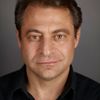Part 5: Brian Binnie Makes History
One of the biggest concerns people have about space travel is whether or not it is safe. Yet, while I was launching into sub-orbit, the safety risk was the last thing on my mind. I was intimately involved in the rocket motor testing of the program and was comfortable with its capabilities and knew our air-launch approach gave us many more safety options than a ground launch of a conventional rocket. That final SpaceShipOne flight required high performance and fine precision to execute well. Because it demanded my full attention, I was just too busy to be concerned for my safety!
I first learned about the X PRIZE while I was working for Rotary Rocket, testing a rocket that we designed and built, and were in the process of trying to fly. It was not until I joined Burt Rutan's Scaled Composites team, under contract for Paul Allen that I thought it was possible to win the prize. At that point, the X PRIZE was unfunded and had no deadline, and yet, despite this, the prize became our motivator; the carrot that pushed us forward. We had a very small team of 30, which enabled us to be agile and flexible. There were not a lot of approvals that had to happen, so we could sit around a coffee table with our notes and make quick decisions that would be rapidly put into motion. We were confident we had the right technology, but the time frame was a major concern. Rightly so, because the initial competition deadline came and went without us sending SpaceShipOne into space. We needed an extension if we were going to succeed, and fortunately, the Ansaris gave it to us when they extended the competition deadline by a year.
We finally completed the test flights for SpaceShipOne with very little time before the second deadline expired. The rules of the competition stipulated that we had to send the vehicle 100 kilometers into space twice in a two week period. The first flight was manned by my teammate Mike Melville, and while the flight was successful, it had some technical issues that needed to be addressed. The deadline forced us to focus. If there had been no X PRIZE, the technical issues in the first flight could have gotten the better of us, but the clock was ticking, so to speak, and we had the prize in our sights. Safety issues with Mike's first X PRIZE flight were mostly a public misunderstanding and did not preoccupy us at Scaled. We certainly wanted to avoid a repeat performance of his "roll record" so that the follow-on effort for Virgin Galactic would have a better chance of being realized.
When the day of my flight finally came, I was working with very little sleep. Prior to the release point, I had an excruciating hour in which I had little to do but sit, think, and come face to face with the demons that lurked into my thoughts as I waited. Would things go according to plan? Had SpaceShipOne revealed to us all its secrets? The flight test was under such a microscope that I couldn't even sneeze - without multiple cameras in the cockpit beaming the images back to the many people watching including the whole Scaled team, the X PRIZE Foundation, Paul Allen, Sir Richard Branson, NASA, and tons of media outlets. Considering that I hadn't flown the vehicle in some 10 months, I felt I was under a huge amount of pressure. Then, after the hour long wait, things shifted into fast forward and everything happened incredibly quickly. After release, I was under the impressive acceleration of the hybrid rocket and thundering toward space. The shuddering and shaking vibrations combined with the demonic screeching of that motor were most memorable. But, by far, the best part was the contrast provided when I shut off the rocket; Blessed peace and quiet and the instant karma of weightlessness. And then, my God, that view! Separating the black void that is space from the peaceful panorama below is a thin blue electric ribbon of light that is the atmosphere. For 4 minutes I got to soak it all in. I tell you, one cannot be unmoved by the experience! From Mojave, I could see the San Francisco Bay to the North, Baja Mexico to the south, the Sierra-Nevada Mountains and the Pacific. I captured some of the sights with a camera but it's definitively something you need to see for yourself.
It was almost possible to forget that I was still driving this spaceship and would have the challenge of bringing it back down to earth. Thankfully, due to the brilliance of Burt's "feather" reentry configuration, that entire phase of flight, normally fraught with danger, was a non-event. There were some moderate G's to endure and lots of noise as the atmosphere welcomed my supersonic return to Earth, but the ride was otherwise syrupy smooth compared to the rumbling ride under the rocket. About 80 minutes after departure, I returned, landing in front of a most enthusiastic and supportive crowd to claim the $10 million X PRIZE with Scaled's distinguished and elated team.
I can describe this incredible experience without the slightest fear of ruining it for you. It is not like a movie - it absolutely cannot be spoiled. Reflecting back on it, I am like many Astronauts I know, struck by one compelling thought - I can't wait to go back.
